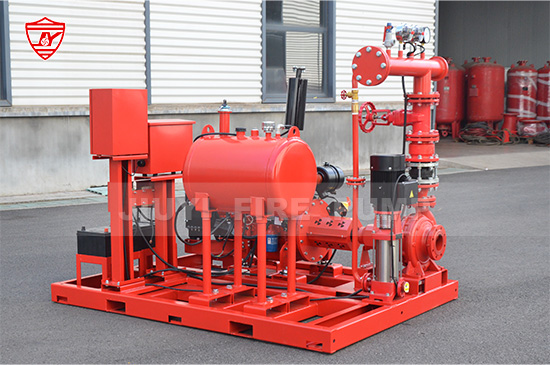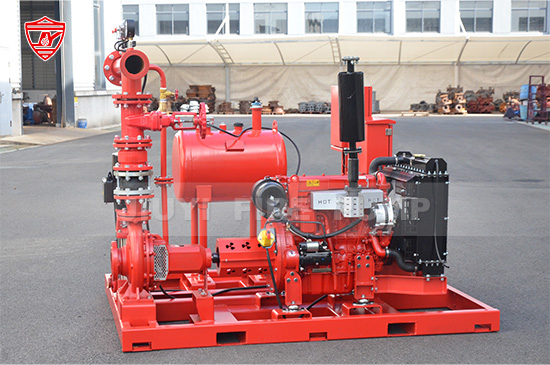In any fire protection system, every component plays a vital role in ensuring safety and reliability. While the pump, motor, and controller often get most of the attention, one crucial element quietly supports them all — the fire pump baseplate. It’s the foundation that ensures the entire system operates with stability, precision, and durability. Understanding what a fire pump baseplate is and its function helps engineers, installers, and maintenance professionals design more effective and long-lasting fire pump systems.

A fire pump baseplate is the rigid, structural platform on which the pump, driver (electric motor or diesel engine), and other components are mounted. Its main purpose is to provide a stable, level, and properly aligned foundation that maintains the correct relationship between the pump and its driver.
The baseplate is typically constructed from heavy-duty steel, cast iron, or fabricated structural frames, designed to handle vibration, torque, and long-term operational stress. It is the core of the fire pump assembly, often referred to as the fire pump skid or pump set base.
In accordance with NFPA 20 (Standard for the Installation of Stationary Pumps for Fire Protection), the baseplate must be rigid and robust enough to maintain pump and driver alignment during operation, shipping, and installation.
The fire pump baseplate performs multiple essential roles within the system. Its function goes beyond simply holding components in place — it directly affects the pump’s performance, longevity, and reliability.
Alignment between the pump and driver is critical for smooth and efficient operation. Even minor misalignment can cause bearing failures, seal leaks, or vibration problems. The baseplate ensures that the shaft centerlines of both the pump and driver remain aligned, minimizing mechanical stress and energy loss.
Fire pumps, particularly diesel engine-driven pumps, produce significant vibration during operation. The baseplate acts as a vibration dampener, spreading and absorbing these forces through its structure. This reduces the risk of damage to the pump, motor, or piping connections.
A solid baseplate anchors the entire fire pump unit. Whether the pump is located in a building basement, pump room, or outdoor enclosure, the baseplate provides the necessary rigidity and stability to prevent movement, tipping, or distortion during operation and maintenance.
Baseplates are typically pre-aligned and factory-assembled before shipping. This simplifies on-site installation, as contractors only need to position and grout the baseplate. It also allows easier access for inspection and maintenance since all components are mounted in a consistent, open layout.
By maintaining alignment and reducing vibration, the baseplate significantly extends the service life of the pump and driver. Properly designed and installed baseplates reduce wear on couplings, bearings, and seals, resulting in fewer breakdowns and lower maintenance costs.
Designing a fire pump baseplate is a precise engineering task. Each element must support the intended performance and meet safety standards.
Common materials include:
Carbon steel – strong, affordable, and easy to fabricate.
Cast iron – excellent vibration damping but heavier and more brittle.
Stainless steel – used in corrosive environments, such as coastal or chemical facilities.
The material must be rigid enough to prevent bending or twisting when under load.
The thickness of the plate affects both stiffness and vibration resistance. A baseplate that’s too thin can flex under load, causing misalignment. Proper reinforcement ribs or structural beams are often added to increase rigidity without excessive weight.
Leveling screws or pads allow fine adjustments to ensure the baseplate is perfectly flat and level before final grouting. This is crucial because uneven foundations can distort the baseplate and misalign the pump.
Well-designed baseplates include drain holes, lifting points, and mounting slots for easy maintenance. Drainage prevents standing water from causing corrosion or rust under the pump and motor.
Fire pump baseplates are typically sandblasted, primed, and painted with industrial-grade coatings to resist corrosion. In marine or humid environments, galvanized or epoxy-coated baseplates are preferred for longer service life.
Proper installation is essential to achieving the baseplate’s intended performance. Even the best-designed baseplate can fail if installed incorrectly.
The baseplate should rest on a concrete foundation that’s strong, level, and properly cured. The surface must be free of cracks or uneven spots. Foundation bolts are embedded in the concrete to secure the baseplate.
Before grouting, the baseplate is carefully positioned and leveled using shims or leveling screws. It’s vital to ensure horizontal accuracy to prevent strain on the pump and driver shafts.
Once level, non-shrink grout is poured beneath the baseplate to fill any voids and ensure full contact with the foundation. Grouting provides stability, prevents vibration, and locks the baseplate firmly in place.
After the grout cures, the pump and driver alignment must be checked again. Slight adjustments may be required, as the curing process can cause minimal shifts.
Finally, the baseplate is securely anchored, and all fasteners are torqued to specification. The entire system is inspected to verify alignment, bolt tightness, and vibration control before commissioning.
Even with careful design and installation, certain problems can occur if baseplate standards are not met.
Misalignment – caused by poor leveling, uneven grouting, or thermal expansion; leads to vibration and premature wear.
Corrosion – from inadequate coating or moisture accumulation under the baseplate.
Foundation settling – results in baseplate distortion and misalignment over time.
Improper bolt tension – can allow components to shift during operation.
Regular inspection and preventive maintenance are the best ways to avoid these issues.
To keep a fire pump baseplate in excellent condition:
Inspect for corrosion or paint damage during every scheduled maintenance cycle.
Ensure all anchor bolts remain tight.
Check alignment periodically, especially after seismic activity or heavy vibration events.
Keep the area under the baseplate dry and clean.
Repaint or recoat surfaces showing signs of rust.
These simple measures help maintain mechanical integrity and ensure continuous, reliable pump performance.
According to NFPA 20, all fire pump assemblies must be securely mounted on a baseplate that maintains alignment under load and vibration. The standard also requires that the manufacturer verify alignment at the factory before shipment.
Following NFPA 20 not only ensures compliance but also guarantees long-term operational safety and performance. Many UL listed fire pumps and FM approved systems incorporate tested and certified baseplates as part of their package.
In modern fire protection design, packaged fire pump sets have become increasingly popular. These complete units — consisting of pump, driver, controller, piping, and baseplate — are assembled and tested in the factory before delivery.
The baseplate is the backbone of such systems, ensuring that every component is precisely positioned and secured. Factory-packaged units reduce on-site installation time, improve reliability, and guarantee proper alignment as tested under operational conditions.

The fire pump baseplate may not be the most visible part of a fire protection system, but its function is absolutely critical. It provides the foundation for alignment, stability, vibration control, and overall performance. Whether for an electric motor-driven or diesel engine-driven fire pump, a properly designed and installed baseplate ensures the system operates smoothly and reliably when it matters most — during a fire emergency.
For manufacturers, installers, and engineers, understanding the structure, purpose, and installation of fire pump baseplates is essential. It’s the unseen strength beneath every successful fire pump system, supporting not just equipment, but also the safety of lives and property.